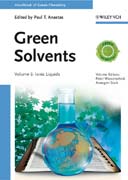
The shift towards being as environmentally–friendly as possible has resulted in the need for this important volume on the role of ionic liquids in green chemistry. Edited by Peter Wasserscheid, one of the pioneers of ionic liquid research, and Annegret Stark, this is an essential resource for anyone wishing to gain an understanding of the world of green chemistry, as well as for chemists, environmental agencies and chemical engineers. The Handbook of Green Chemistry comprises of 9 volumes in total, split into 3 subject–specific sets. The three sets are available individually. All 9 volumes are available individually, too. Set I: Green Catalysis – Volume 1: Homogeneous Catalysis – Volume 2: Heterogeneous Catalysis – Volume 3: Biocatalysis Set II: Green Solvents – Volume 4: Supercritical Solvents – Volume 5: Reactions in Water – Volume 6: Ionic Liquids Set III: Green Processes – Volume 7: Green Synthesis – Volume 8: Green Nanoscience – Volume 9: Designing Safer Chemicals The Handbook of Green Chemistry is also available as Online Edition . Podcasts Listen to two podcasts in which Professor Paul Anastas and Journals Editor Paul Trevorrow discuss the origin and expansion of Green Chemistry and give an overview of The Handbook of Green Chemistry . INDICE: Preface PART I: Green Synthesis THE GREEN SYNTHESIS OF IONIC LIQUIDS The Status Quo of Green Ionic Liquid Syntheses Ionic Liquid Preparations Evaluated for Greenness Which Principles of Green Chemistry are Relevant to Ionic Liquid Preparations? Atom Economy and the E–Factor Strengths, Weaknesses, Opportunities, Threats (SWOT) Analyses Conductive Heating Preparation of 1–Alkyl–3–Methylimidazolium Halide Salts Purification of 1–Alkyl–3–Methylimidazolium Halide Salts Ionic Liquid Syntheses Promoted by Microwave Irradiation Syntheses of Ionic Liqudis Promoted by Ultrasonic Irradiation Simultaneous Use of Microwave and Ultrasonic Irradiation to Prepare Ionic Liquids Preparation of Ionic Liquids Using Microreactors Purification of Ionic Liquids with Non–Halide Anions Decolorization of Ionic Liquids Conclusion PART II: Green Synthesis Using Ionic Liquids GREEN ORGANIC SYNTHESIS IN IONIC LIQUIDS General Aspects Friedel–Crafts Alkylation TRANSITION METAL CATALYSIS IN IONIC LIQUIDS Solubility and Immobilization of Transition Metal Complexes in Ionic Liquids Ionic Liquid–Catalyst Interaction Distillative Product Isolation from Ionic Catalyst Solutions New Opportunities for Biphasic Catalysis Green Aspects of Nanoparticle and Nanocluster Catalysis in Ionic Liquids Gren Aspects of Heterogeneous Catalysis in Ionic Liquids Green Chemistry Aspects of Hydroformylation Catalysis in Ionic Liquids Conclusion IONIC LIQUIDS IN THE MANUFACTURE OF 5–HYDROXYMETHYLFURFURAL FROM SACCHARIDES. AN EXAMPLE OF THE CONVERSION OF RENEWABLE RESOURCES TO PLATFORM CHEMICALS Introduction HMF Manufacture Goals of Study HMF Manufacture in Ionic Liquids ? Results of Detailed Studies in the Jena Laboratories Conclusion CELLULOSE DISSOLUTION AND PROCESSING WITH IONIC LIQUIDS General Aspects Dissolution of Cellulose in Ionic Liquids Rheological Behavior of Cellulose Solutions in Ionic Liquids Regeneration of the Cellulose and Recycling of the Ionic Liquid Cellulosic Fibers Cellulose Derivatives Fractionation of Biomass with Ionic Liquids Conclusion and Outlook PART III: Ionic Liquids in Green Engineering GREEN SEPARATION PROCESSES WITH IONIC LIQUIDS Introduction Liquid Separations Environmental Separations Combination of Separations in the Liquid Phase with Membranes Gas Separations Engineering Aspects Design of a Separation Process Conclusions APPLICATIONS OF IONIC LIQUIDS IN ELECTROLYTE SYSTEMS Introduction Electrolyte Properties of Ionic Liquids Electrochemical Stability Dye–Sensitized Solar Cells IONIC LIQUIDS AS LUBRICANTS Introduction Why Are Ionic Liquids Good Lubricants? Applications, Conclusion and Future Challenges NEW WORKING PAIRS FOR ABSORPTION CHILLERS Introduction Absorption Chillers Requirements and Challenges State of the Art and Selected Results Abbreviations PART IV: Ionic Liquids and the Environment DESIGN OF INHERENTLY SAFER IONIC LIQUIDS: TOXICOLOGY AND BIODEGRADATION Introduction (Eco)Toxicity of Ionic Liquids Biodegradability of Ionic Liquids Conclusion ECO–EFFICIENCY ANALYSIS OF AN INDUSTRIALLY IMPLEMENTED IONIC LIQUID–BASED PROCESS ? THE BASF BASIL PROCESS The Eco–Efficiency Analysis Tool The Methodological Approach The Design of the Eco–Efficiency Study of BASIL Selected Single Results The Creation of the Eco–Efficiency Portfolio Scenario Analysis Conclusion Outlook PERSPECTIVES OF IONIC LIQUIDS AS ENVIRONMENTALLY BENIGN SUBSTITUTES FOR MOLECULAR SOLVENTS Introduction Evaluation and Optimization of R&D Processes: Developing a Methodology Assessment of Ionic Liquid Synthesis ? Case Studies Assessment of the Application of Ionic Liquids in Contrast to Molecular Solvents Conclusions
- ISBN: 978-3-527-32592-4
- Editorial: Wiley VCH
- Encuadernacion: Cartoné
- Páginas: 365
- Fecha Publicación: 14/08/2013
- Nº Volúmenes: 1
- Idioma: Inglés
